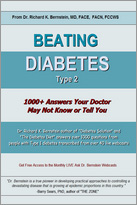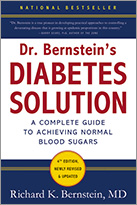Frank Purcell is a seventy-six-year-old retiree who, like many of my married patients, works closely with his wife to keep his diabetes on track. Eileen, who goes by the nickname Ike, tells the first part of his story.
Ike: “Frank had been treated for many years for diabetes, and had been treated orally because he was a Type II. As far as we were aware, he had a functioning pancreas. The thing was, as a younger man, he’d been told that he had high blood sugar, but it was ignored. This was going back to his army days, in 1953 or so. No one suggested medication, no one called it diabetes, and nothing more was done. They just said he had high blood sugar. They called it ‘chemical’ diabetes. It showed up on blood tests, but not on urinalysis. I guess in those days, having it show up on a urinalysis was some sort of determinant. He did modify his diet—he stopped eating so much candy, and he took off weight—he lost about 30 pounds in those days.
“In about 1983, Frank had a mild heart attack. He began to see a cardiologist, who has been monitoring his health care very carefully since then. For about two to three years, he took beta blockers and maybe one or two heart medications. As far as we could tell, his heart problems were very much in resolution—I mean he’d had a heart attack, he’d had no surgery, and seemed to be doing okay. But when he started working with the cardiologist, the doctor noted that his blood sugar thing was ongoing, and he began to feel it was of concern. He prescribed Diabinese, which was the oral medication of choice of the time, I guess, and he monitored Frank’s blood sugar about every four months.
“I might say that I never even knew what a normal blood sugar was. No one ever talked about it. I had no idea whether it was 1,000 or 12. The only thing we were ever told was that it was high or wasn’t high. This went on and on for close to seven or eight years. If he had seen Dr. Bernstein back then, who knows what could have been different? But eventually, the cardiologist said he thought Frank ought to see an endocrinologist. He didn’t feel he was able to control Frank’s blood sugar well enough himself with medication, and so he felt the condition warranted closer attention.
“We went to see a gentleman who was chief of the diabetes clinic at a major hospital here in upstate New York, where we live. Now, this is a very well thought of medical facility. The doctor met with us, and he kept Frank on the Diabinese, and monitored him every three months or so. His blood sugars were 253, 240, and he would say, ‘Let’s try another pill.’ It was always medication. Glyburide, Glucophage—the whole bit. But trying to get his blood sugar down was very difficult. No one ever mentioned diet, really. And rarely was it ever below 200 when we went in. Rarely. When I finally found out what the numbers meant, I said to the doctor, ‘Don’t you think we ought to see a dietitian? I mean, we’re eating the same food we always have.’ We were on the normal diet that anybody’s on. I had friends who are diabetics who watch certain things that they eat, and so I thought it made a certain amount of sense. He said, ‘Sure. That’s a really good idea.’
“He gave us the name of a young woman, and we saw her three times. She said, ‘Eat eleven carbohydrates everyday,’ and she gave us the food pyramid—we didn’t need her for that—and nothing changed, except Frank stopped eating dessert. He would have the occasional bowl of ice cream, or a piece of cake when he felt like it, or a cookie. I always bought the newest foods that came out—low-fat, low-sugar. I was more concerned about fat during that stage, as I recall.
“This went on until God intervened. I mean that. What happened was, Frank had an attack of serious hypoglycemia. No one had warned us that this could happen. No one had told us what hypoglycemia looked like. I thought it was a stroke. He was out of his head. He couldn’t answer questions. The only thing that gave me some smidgen of doubt was that he got up and walked to the bathroom and put on his trousers. I called 911. When the medic got here, he hooked him up to some glucose, put him on a gurney and trundled him out of here, and headed for the medical center. In the middle of the ride, Frank woke up and said, ‘What the hell am I doing here?’ The young man said he certainly seemed to be coming out of his stroke well. By the time we got to the hospital, he was virtually himself. When they decided to do a finger stick, his blood sugar was 26, 26 mg/dl. I didn’t have the education in diabetes that I’ve gotten with Dr. Bernstein, but I knew enough to know that this was not good. Who knows what it was before he got the intravenous?
“Now, we’ll never know if he accidentally took his medication twice the night before—it’s very possible—but I tell you, however it happened, it was the Lord who was watching over Frank and said, ‘Now it’s time to do something.’ As scary as it was, it was also a blessing.
“I have a doctor friend who’s a close colleague of Dick Bernstein’s. My friend had had an uncle who’d been very ill with diabetes and its complications, but his life had been prolonged in a much more comfortable fashion by Dick Bernstein. I would talk to my friend about Frank’s diabetes, and he’d say to me, ‘Nothing’s really going to change. You’re not going to get his blood sugars down until you see Dick Bernstein.’ Even though my friend is a doctor, I brushed off his advice. Frank was seeing a doctor. Why would some private doctor be any more capable than the head of the diabetes clinic at a major medical center? But after this episode with hypoglycemia, Frank went to my friend’s office with me, and my friend laid it out for him, told us in grinding detail what we could expect from Dr. Bernstein, what it would be like, and how he hoped we would relate to Dick, because he’s rather controversial, and how hard it was going to be—how much of a commitment it was going to take. We went away thinking, ‘Let’s give it a try.'”
Frank: “To be honest, when I first met Dr. Bernstein, I felt he was somewhat of a flake. I had worked with doctors in the army, and I was used to a particular kind of guy. Dr. Bernstein—now, he’s a horse of another color. Until I came across him, I never met a doctor who was so focused on one thing. He is so completely directed toward this one failing of the human body that I kind of thought that maybe it was a little too intense. But the results have been rather spectacular, and I’m very happy with him. He has specific programs, he has direction, he has goals, and he is not sidetracked by anything other than tending to diabetes. He’s given me a regimen. I keep track of my blood sugar, and it’s pretty much under control. Instead of blood sugar counts of over 200, I now get them in the range of 85 to 105, which was the goal he set for me. I take insulin in the morning and before midday and evening meals, and before I go to bed. I don’t eat ice cream, and I don’t do a lot of things I used to do routinely. When I first came to Dr. B., I was looking very pale and wan, and now I’m looking much ruddier and healthier. I’m a little irritated with this constant puncturing of my fingers, but I just do it automatically now, like second nature.
“When I found out I was going to have to inject insulin, I just broke down and cried. It was like the final straw, and I thought, ‘My life is over.’ Now I hardly think about it. I use Dr. Bernstein’s painless injection method and it doesn’t bother me at all. It only takes a split second. The needle is so tiny, I almost have no feeling at all. I use the ‘love handles’ on the sides of my waist. Now, I’m a pretty skinny guy, so there isn’t much there, but I can hardly feel it. To do it properly, it took me about two weeks to learn. He made me do it in the office. He showed me—did it to himself—and then he made me do it. Since then, I just do it routinely, all on my own. If I’m out, I do it wherever I am—in a restaurant, in the men’s room—I’m not the least bit ashamed and no one seems much to notice.”
Ike: “About the insulin, I had the feeling that it was going to be inevitable, and when Frank got the news he just broke into tears and really felt that this was the final insult. He’d had many physical problems, and insulin seemed like a very low blow for him. But he did it, stayed with the program, and within a month to six weeks, we began to feel that we were on top of this, knew what was going on. He can manage his blood sugar when it’s a little low, when it’s a little high. He knows just what to do. His overall health has improved since the beginning. Dr. Bernstein really gave us an education.”




